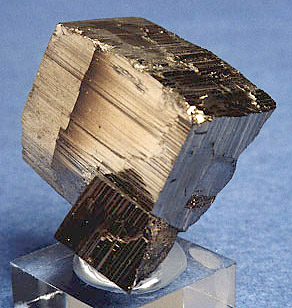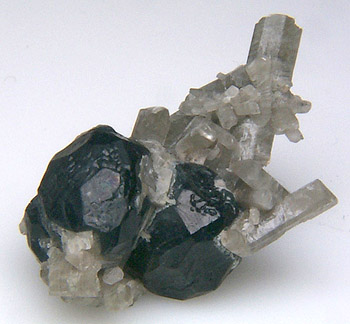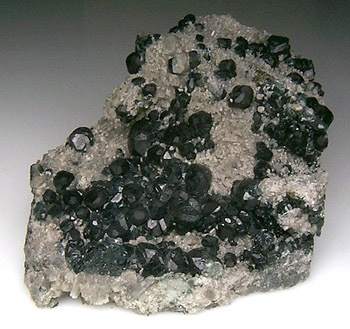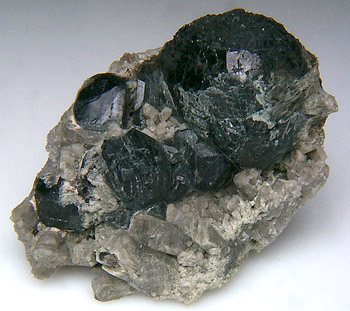 |
|||
|
|||
|
Copyright Some Collectable Mineral Localities in Nunavut BY DIRK SCHMID AND DOUG MILLER
Nanisivik MineThe Nanisivik Mine is best known for producing fine quality pyrite and calcite specimens. This mine is located on northwestern Baffin Island. It has been in continuous production for over 20 years. Exceptional museum-quality specimens have been obtained from this locality, and some are on display at the Pacific Mineral Museum in Vancouver, the Royal Ontario Museum in Toronto and the Canadian Museum of Nature in Ottawa. Fine specimens are prized by collectors around the world. The pyrites from this locality typically form cubes, some showing striations along the sides of the crystals (Figure 1). Well-formed dolomite crystals may be found in association with the pyrite crystals. Calcite crystals have also been obtained.An excellent article on the minerals of the Nanisivik Mine was published in the Mineralogical Record in 1990 (see below) and provides an in depth look at the mine, geology, and specimens from this locality.
Calcite Pseudomorphs from EurekaCalcite pseudomorphs after the mineral ikaite have been found near Eureka on Ellesmere Island (Figure 2). These specimens usually appear reddish-brown or light brown in colour and usually form a rosette ball with 10 mm long crystals. Specimens collected recently from this locality measured about 4 to 5 cm in diameter. The pseudomorphs require some cleaning to remove the residual mud from between the crystals. These specimens are available from Northern Lights Minerals, a website maintained by Doug Miller in Saskatoon.
Polaris MineThe Polaris Mine on Little Cornwallis Island has produced a variety of interesting galena specimens. Excellent miniature clusters of consisting of galena cubes associated with sphalerite, calcite, and dolomite in an aesthetic arrangement have been found. Although small, such specimens are a delight and should not be overlooked. Some galena specimens occur as bright lustrous cubes or partial cubes, sometimes with octahedral modifications (Figure 3). Sizes vary from crystals less than 1 cm, to cubes 3 to 5 cm, or larger. Galena cubes are attached at one end to the matrix of the host rock. But when detached, they can still make nice specimens. There are not many specimens from this locality.The Polaris Mine is an underground zinc-lead mine, which is operated by Cominco Ltd. The mine is owned by Cominco (77.5%) and Rio Algom (25%). Polaris is scheduled to close down in a few years.
Spinels from MacDonald Island VicinityDark blue spinels with diopside have been found near MacDonald Island (Figures 4, 5 and 6). The spinels vary in size, and can be less than 1 cm in diameter, or as large as 3 to 4 cm in diameter. Many of the specimens found contain clusters of spinels on a diopside matrix. Specimens range from thumbnails to large cabinet size. Some spinel specimens can be a bit fragile, and extra care is required. Spinel itself is a magnesium aluminum oxide mineral, with a Mohs hardness ranging between 7.5 and 8. The spinels from this locality are rounded, unlike the fine sharp crystals found at the Ross Township locality in Ontario.
Lake Harbour SettlementThere is one excellent marble locality on the south side of Baffin Island near the Lake Harbour settlement. A brief reference to this locality was mentioned in an article published in the October 1977 issue of the original Canadian Rockhound magazine (Vol. 21, No. 5). The marble localities near Lake Harbour are remarkable for having produced lapis lazuli, gem quality amphiboles, wonderful phlogopite mica, and perhaps the world's best graphite crystals ever found (John Biczok, personal communication).
Other LocalitiesNear Rankin Inlet, nickel and pentlandite have been found in the waste piles of the old Rankin Inlet Mine. The mine was closed many years ago. There are several other, but lesser known and explored localities in Nunavut where minerals deposits have been found. But these are not covered here, due to the limited information currently available. Future exploration of Nunavut and its geology may reveal new sources of fine minerals.
Further Reading
Related Websites
Copyright © 2001 Dirk Schmid and Doug Miller This article may not be copied, distributed or reprinted in any form without the authors' permission. To contact the authors, please use the e-mail address provided. If you are unable to contact the author, please contact the Canadian Rockhound. Authorized reprints must acknowledge the authors and the Canadian Rockhound, and include the website URL address of the Canadian Rockhound. All photographs are copyright © 2000 by Doug Miller. Photographs used in this article may not be copied, distributed or reprinted in any form without permission.
|
||
 
Copyright © 2001 Canadian Rockhound
Back Issues |
News & Events |
Junior Rockhound
|
||





